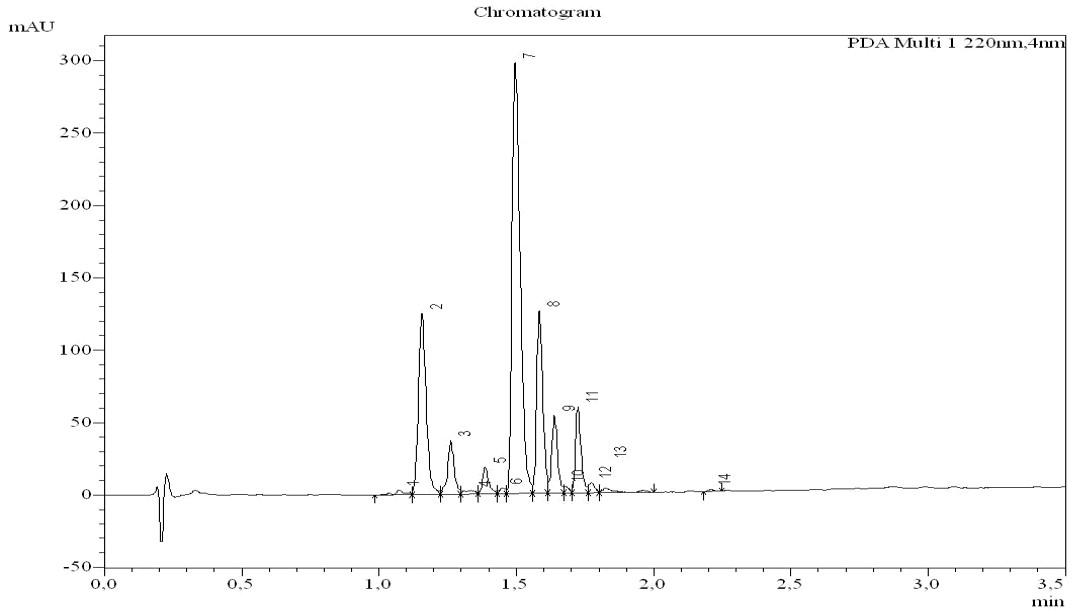ASPARTIMIDE FORMATION
Measures to Tackle an Undesired Side Reaction

circle-arrow-right
Down. Set. Hut.
Frustrated by aspartimide formation during peptide synthesis? Get ready to discover different strategies to minimize or avoid the formation of these undesired side products.
pages 1 – 6
pages 2 – 3
Aspartate derivatives – bulky esters and cyanosulfurylides.
page 3
page 3
Di- and trimethoxybenzyl Glycine for amide backbone protection.
Tuning the reaction conditions to minimize aspartimide formation.
.
Version: IF18_2
Aspartimide Formation
Aspartimide Formation
Measures to Tackle an Undesired Side Reaction
Chemical Background
Although peptide chemistry is constantly developing, t he event of aspartimide formation represents a serious challenge during the synthesis of aspartate-containing peptides as it leads to lowered yields, difficult purifications, or even inaccessible sequences. This side reaction is strongly sequence dependent and preferably occurs at Asp-Aaa motifs (Aaa = Gly, Asp, Asn, Gln or Arg). In a first step, the cyclic aspartimide is formed upon ring-closure between the nitrogen of the alpha-carboxyl amide bond and the beta-carboxyl sidechain and release of the carboxyl protecting group. The formed aspartimides undergo rapid epimerization followed by ring opening either by hydrolysis or by virtue of base, leading to (epimerized) alpha- and beta-Asp peptides and corresponding piperidides. As this side reaction is promoted by strong bases such as piperidine, which is commonly used for Fmoc removal, this problem is especially pronounced during Fmoc SPPS.
acid or base (racemization)
D/L-aspartimide
D/L-α-peptide (epimerized)
D/L-β-peptide (epimerized)
Aspartimide formation and possible side products.
D/L-β-piperidides (epimerized)
D/L-α-piperidides (epimerized)
Thus, aspartimide formation leads to lowered product yields in addition to time- and cost-intensive purification. As some of those by-products are even co-eluting on HPLC due to identical retention times compared to the desired product, they may be virtually impossible to remove rendering certain peptide sequences totally inaccessible. Over the last decades, several approaches – based on the employment of specific building blocks and/or tuning the reaction conditions – have been developed to avoid this side reaction.
Iris Biotech GmbH • Email: info@iris-biotech.de • www.iris-biotech.de • Empowering Peptide Innovation
1
N H H N O O O R N H N O O N H H N O OH O N H OH O N H O N H H N O O N N H O O N N H O hydrolysis piperidine

Chromatogram of the model sequence VK DG YI-OH after treatment with 30% piperidine. Peak number 2 – target peptide, 3 – aspartimide, 7/8/9/11 – piperidides.
Strategies
Use of Sterically Demanding Aspartate Derivatives
Aspartimide formation can be decreased by increasing the steric bulk of the side chain aspartic acid ester moiety. Besides the classical Fmoc-L-Asp(OtBu)-OH (FAA1020), Iris Biotech offers bulky ester derivatives with increased steric demand.
FAA1020 Fmoc-L-Asp(OtBu)-OH
FAA1970 Fmoc-L-Asp(PP)-OH
FAA8120 Fmoc-L-Asp(OMpe)-OH
Bulky Aspartate derivatives offered by Iris Biotech.
FAA8235 Fmoc-L-Asp(OEpe)-OH
FAA8125 Fmoc-L-Asp(OBno)-OH
Analogues of the tert-butyl group in which at least one of the methyl groups is replaced by a bulkier alkyl or aryl substituent help to shield the aspartyl beta-carboxyl group and thereby reduce the formation of aspartimide-derived by-products. The more sterically demanding the bulky Asp side chain protecting group, the lower the degree of aspartimide formation. Thus, our bulky side-chain protecting groups provide considerably more protection against the formation of aspartimide-related by-products than the commonly used OtBu group.
A Cyanosulfurylide-Protected Aspartate
Using cyanosulfurylide (CSY) as Aspartate side chain protecting group allows to completely suppress the event of aspartimide formation. In contrast to hydrophobic bulky Asp derivatives, which often suffer from poor solubility and low coupling efficiency, CSY benefits of enhanced solubility. The CSY protecting group can be selectively and quantitatively cleaved from protected or unprotected peptides under aqueous conditions with electrophilic halogen species, e.g. N-chlorosuccinimide, to regenerate the carboxylic acid from the ylide, while being stable towards strong reducing agents, transition metals,
Iris Biotech GmbH • Email: info@iris-biotech.de • www.iris-biotech.de • Empowering Peptide Innovation 2
Fmoc H N (S) O OH O O
Fmoc H N (S) O OH O O
Fmoc H N (S) O OH O O
Fmoc H N (S) O OH O O
Fmoc H N (S) O OH O O
Aspartimide Formation
strong acids and strong bases. Even though removal of this protecting group can be performed on-resin as well as in solution, the latter is recommended for best results. As cyanosulfurylides are absorbing strongly at 254 nm their cleavage can easily be monitored by HPLC analysis as varying amounts of NCS might be required depending on peptide sequence, purity, and concentration.
Postulated mechanism for the recovery of the free acid from the ylide by virtue of a halogen source.
Even though this building block allows to suppress aspartimide formation, other side products are observed, even when using morpholine as very weak cleaving reagent. Possible side reactions include the oxidation of Cysteine, Methionine, and Tryptophane. Besides, chlorination of Tyrosine might occur upon cleavage of the CSY group when using a large excess of N-chloro-succinimide.
Di- and Trimethoxybenzyl Glycine for Amide Backbone Protection
When the Aspartate within the desired peptide sequence is next to a Glycine, the use of di- or trimethoxybenzyl (DMB/TMB) is highly beneficial in order to prevent aspartimide formation. Dmb acts as an auxiliary protecting group temporarily masking the amide nitrogen of a peptide bond. Its efficacy and ease of introduction under standard coupling methods, e.g. PyBOP®/DIPEA or DIPCDI/HOBt, make it a valuable building block. After successful peptide synthesis, the N-Dmb group can be removed by addition of TFA, typically during TFA cleavage of the peptide from the resin. Iris Biotech offers FmocDmbGly-OH (FAA3390), Fmoc-TmbGly-OH (FAA3400) as well as the precoupled dipeptide building block Fmoc-L-Asp(tBu)-DmbGly-OH (FDP1380) for the ease of synthesis. Despite its advantages, as possible side reaction, the Dmb group might react with „in-sequence“ Tryptophanes.
Tuning Reaction Conditions
Besides using specific building blocks, also the choice of the reaction conditions has an impact on aspartimide formation. When a weak Fmoc cleaving reagent, e.g. morpholine (pK a morpholine = 8.4) is used, almost no aspartimide formation is observed. However, sometimes this cleavage reagent is not sufficient for complete Fmoc removal, thus, stronger ones, e.g. 30% piperidine (pK a piperidine = 11.2), have to be used. Depending on the sequence, the addition of acid (e.g. 30% piperidine/0.1 M formic acid) can help to reduce aspartimide formation.
Iris Biotech GmbH • Email: info@iris-biotech.de • www.iris-biotech.de • Empowering Peptide Innovation
3
O S CN Me Me N O O Cl O S NC Me Me Cl H2O S NC Me Me Cl OH HO S CN Cl Me Me O OH
FAA1020
Fmoc-L-Asp(Ot Bu)-OH
N-alpha-(9-Fluorenylmethyloxycarbonyl)-L-aspartic acid beta-t-butyl ester
CAS-No. 71989-14-5
Formula C 23 H25NO 6
Mol. weight 411,45 g/mol
FAA1970
Fmoc-L-Asp(OPP)-OH
N-alpha-(9-Fluorenylmethyloxycarbonyl)-L-aspartic acid beta-(2-phenylisopropyl ester)
CAS-No. 200336-86-3
Formula C 28 H27NO 6
Mol. weight 473,52 g/mol
FAA8120
Fmoc-L-Asp(OMpe)-OH
N-alpha-(9-Fluorenylmethyloxycarbonyl)-L-aspartic acid beta-3-methylpentyl ester
CAS-No. 180675-08-5
Formula C 25H29 NO 6
Mol. weight 439,51 g/mol
FAA8125
Fmoc-L-Asp(OBno)-OH
N-alpha-(9-Fluorenylmethyloxycarbonyl)-L-aspartic acid beta-(5-butylnon-5-yl) ester
CAS-No. 1799418-06-6
Formula C 32H43 NO 6
Mol. weight 537,70 g/mol
FAA8235
Fmoc-L-Asp(OEpe)-OH
N-alpha-(9-Fluorenylmethyloxycarbonyl)-L-aspartic acid beta-3-ethylpentyl ester
CAS-No. 1799418-01-1
Formula C 26 H31NO 6
Mol. weight 453,54 g/mol
FAA3390 Fmoc-DmbGly-OH
N-alpha-(9-Fluorenylmethyloxycarbonyl)-N-alpha-(2,4-dimethoxybenzyl)-glycine
CAS-No. 166881-42-1
Formula C 26 H25NO 6
Mol. weight 447,48 g/mol






Product details Iris Biotech GmbH • Email: info@iris-biotech.de • www.iris-biotech.de • Empowering Peptide Innovation 4
OH (S) O H N O O O O
OH (S) O H N O O O O
OH (S) O H N O O O O
OH (S) O H N O O O O
OH (S) O H N O O O O
OH O N O O MeO OMe
Aspartimide Formation
FAA3400
Fmoc-TmbGly-OH
N-alpha-(9-Fluorenylmethyloxycarbonyl)-N-alpha-(2,4,6-trimethoxybenzyl)-glycine
CAS-No. 166881-43-2
Formula C
NO
FDP1380 Fmoc-L-Asp(t Bu)-DmbGly-OH
N-alpha-(9-Fluorenylmethyloxycarbonyl)-L-aspartic acid beta-t-butylester-N’-(2,4-dimethoxybenzyl)-glycine
CAS-No. 900152-72-9 Formula C
FAA8480
Fmoc-L-Asp(CSY)-OH
N-alpha-(9-Fluorenylmethyloxycarbonyl)-L-aspartic acid cyanosulfurylide
CAS-No. 2379679-90-8
Formula C 23 H22N2O
FAA8483 Fmoc-D-Asp(CSY)-OH
N-alpha-(9-Fluorenylmethyloxycarbonyl)-D-aspartic acid cyanosulfurylide




Product details Iris Biotech GmbH • Email: info@iris-biotech.de • www.iris-biotech.de • Empowering Peptide Innovation 5
N O O O OH MeO OMe OMe
27
27
7 Mol.
g/mol
H
weight 477,51
(S) HN O N O OH MeO OMe O O O O
34
38
2O 9 Mol. weight 618,68 g/mol
H
N
HN (S) OH O O S CN Me Me O O
5
Mol. weight 438,50 g/mol
S
HN (R) OH O O S CN Me Me O O Formula C 23 H22N2O 5 S Mol. weight 438,50 g/mol
References:
→ Preventing aspartimide formation in Fmoc SPPS of Asp-Gly containing peptides - practical aspects of new trialkylcarbinol based protecting groups; R. Behrendt, S. Huber, P. White; J. Pept. Sci. 2016; 22(2): 92-97. https://doi.org/10.1002/psc.2844
→ New t-butyl based aspartate protecting groups preventing aspartimide formation in Fmoc SPPS; R. Behrendt, S. Huber, R. Marti, P. White; J. Pept. Sci. 2015; 21(8): 680-687. https://doi.org/10.1002/psc.2790
→ 2-phenyl isopropyl esters as carboxyl terminus protecting groups in the fast synthesis of peptide fragments; C. Yue, J. Thierry, P. Potier; Tetrahedron Lett. 1993; 34: 323-326. https://doi.org/10.1016/S0040-4039(00)60578-6
→ The aspartimide problem in Fmoc-based SPPS. Part I; M. Mergler, F. Dick, B. Sax, P. Weiler, T. Vorherr; J. Pept. Sci. 2003; 9(1): 36-46. https://doi.org/10.1002/psc.430
→ A new protecting group for aspartic acid that minimizes piperidine-catalyzed aspartimide formation in Fmoc solid phase peptide synthesis; A. Karlström, A. Undén; Tetrahedron Lett. 1996; 37(24): 4243-4246. https://doi.org/10.1016/0040-4039(96)00807-6
→ The aspartimide problem in Fmoc‐based SPPS. Part II; M. Mergler, F. Dick, B. Sax, C. Stähelin, T. Vorherr; J. Pept. Sci. 2003; 9(8) : 518-526. https://doi.org/10.1002/psc.473
→ Prevention of aspartimide formation during peptide synthesis using cyanosulfurylides as carboxylic acid-protecting groups; K. Neumann, J. Farnung, S. Baldauf, J. W. Bode; Nat. Commun. 2020; 11: 982. https://doi.org/10.1038/s41467-020-14755-6
→ Patent EP 2 886 531 B1
→ Acid-Mediated Prevention of Aspartimide Formation in Solid Phase Peptide Synthesis; T. Michels, R. Dölling, U. Haberkorn, W. Mier; Org. Lett. 2012; 14(20): 5218-5221. https://doi.org/10.1021/ol3007925 .
For more details, watch the recording of our workshop about measures to prevent aspartimide formation!
Iris Biotech GmbH • Email: info@iris-biotech.de • www.iris-biotech.de • Empowering Peptide Innovation 6
circle-arrow-right
Empowering Peptide Innovation



